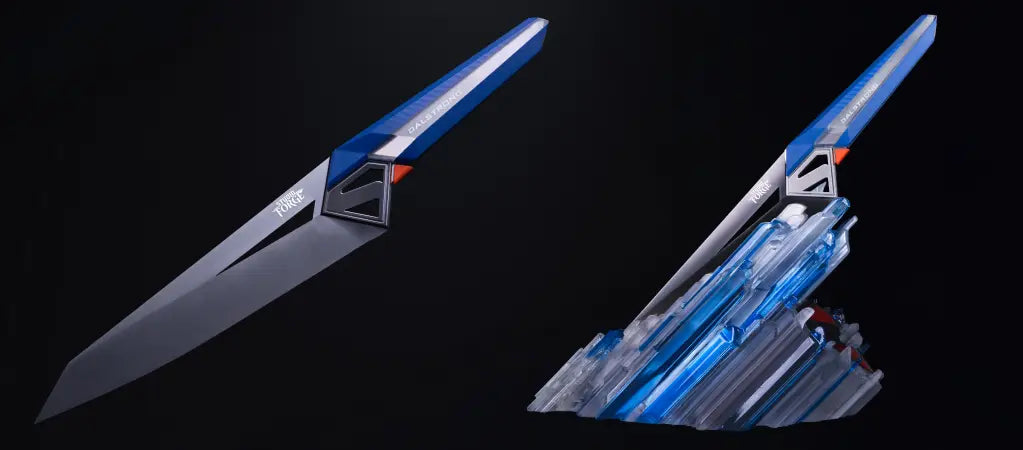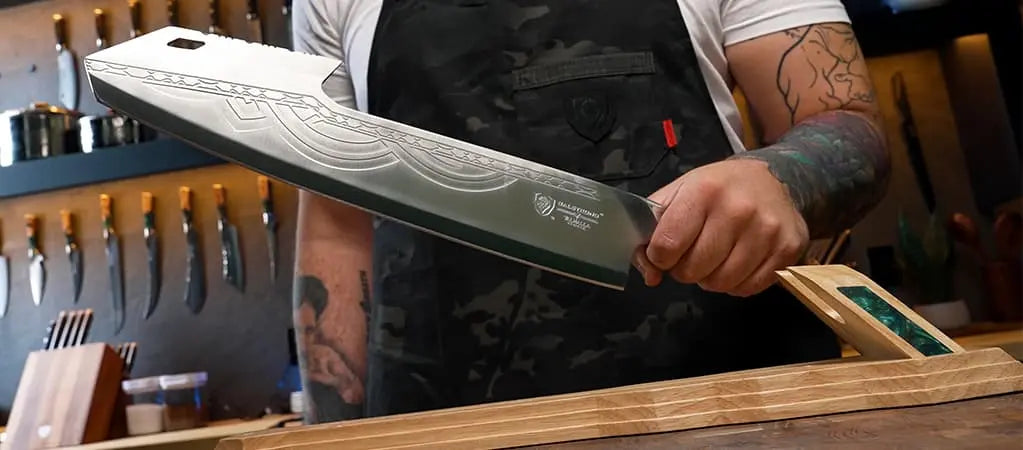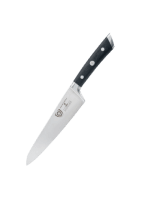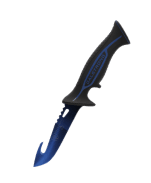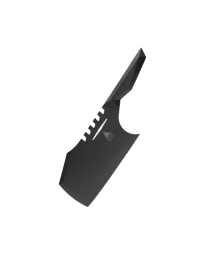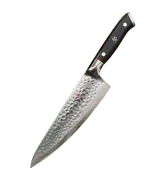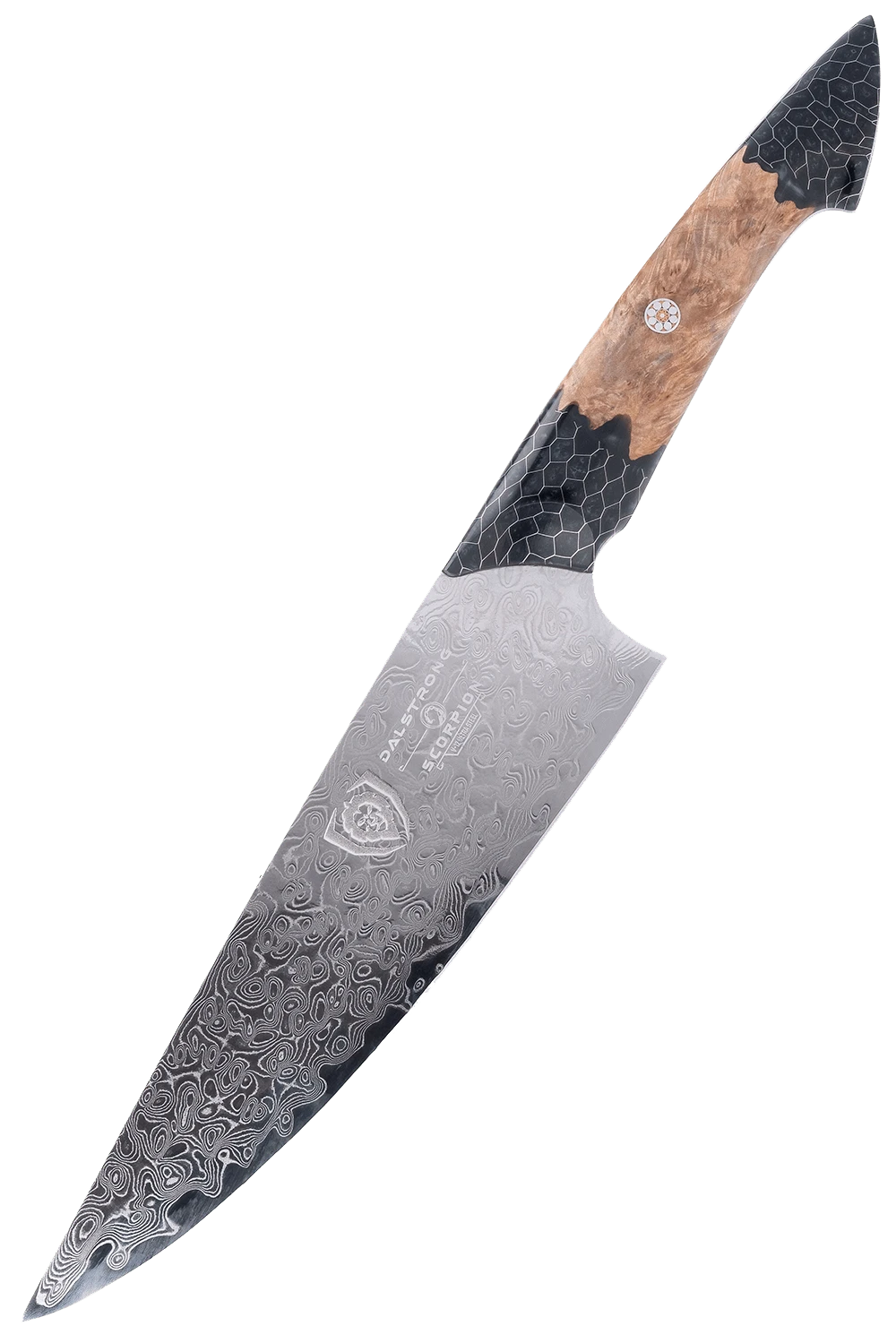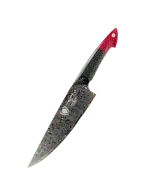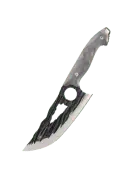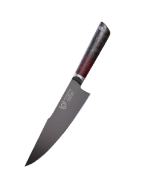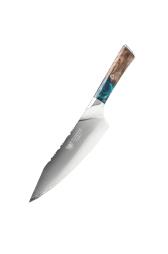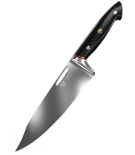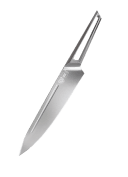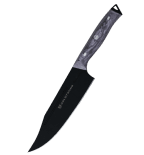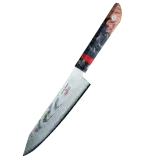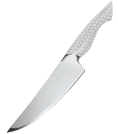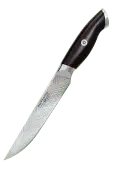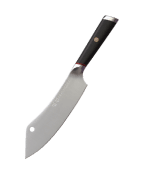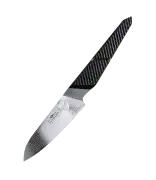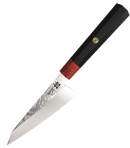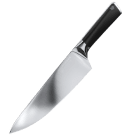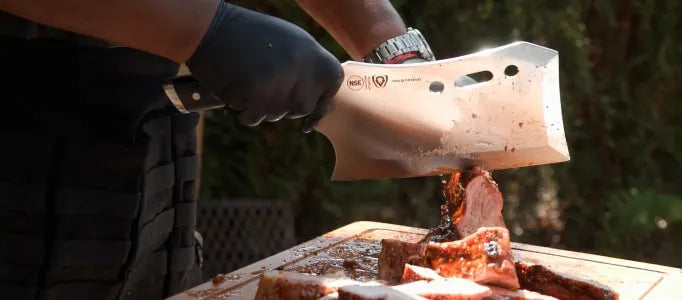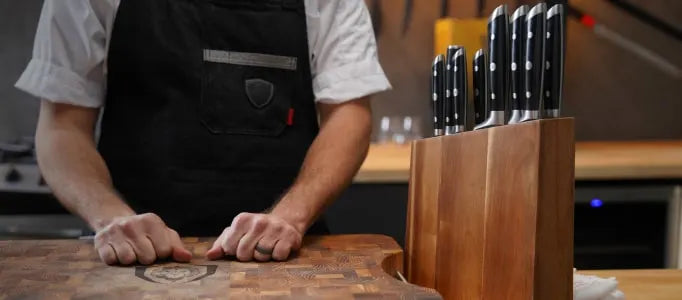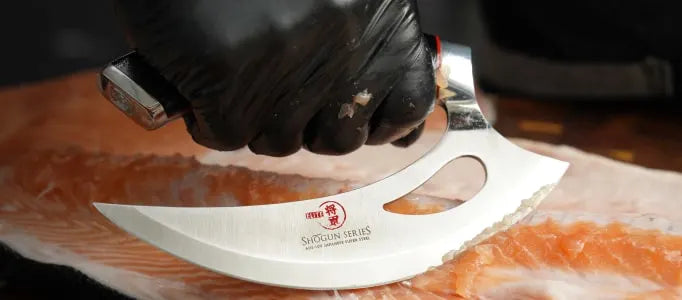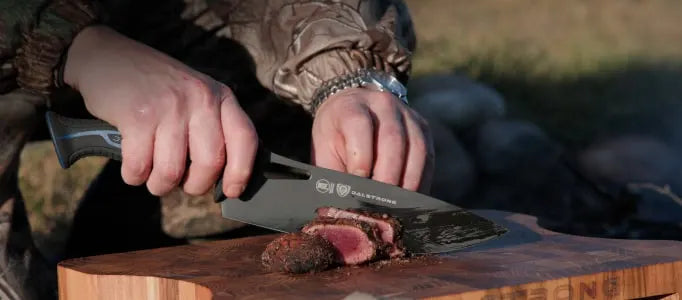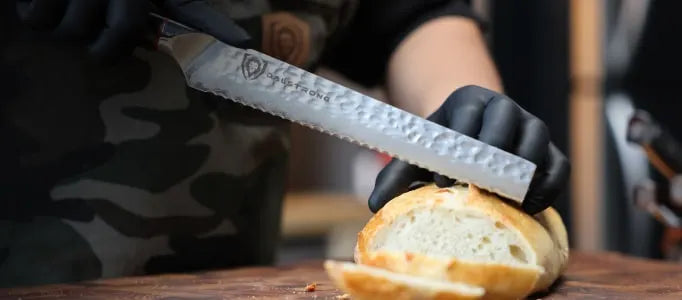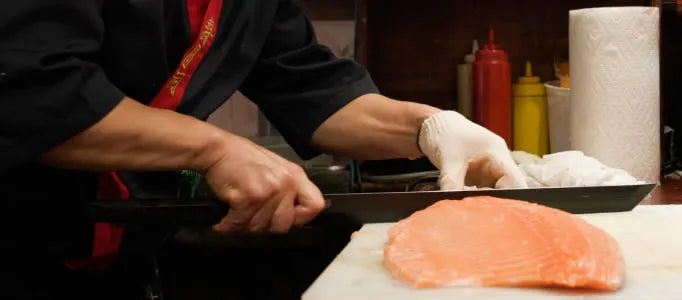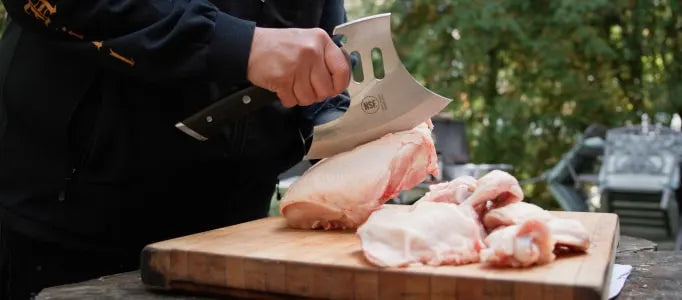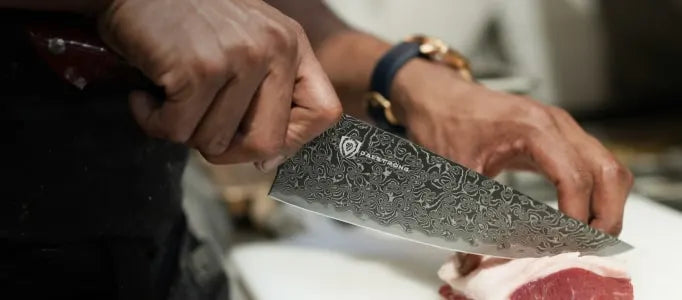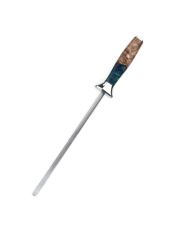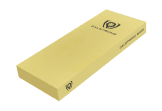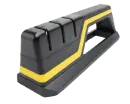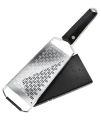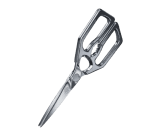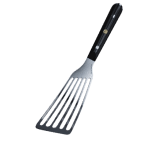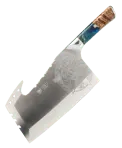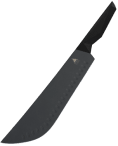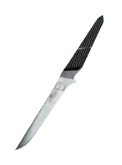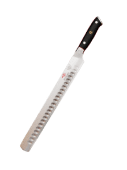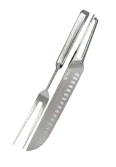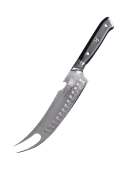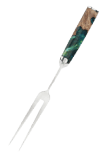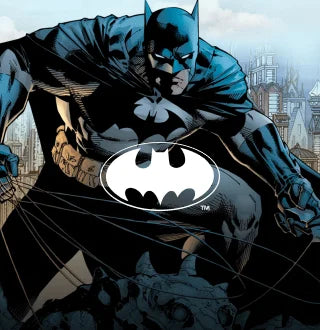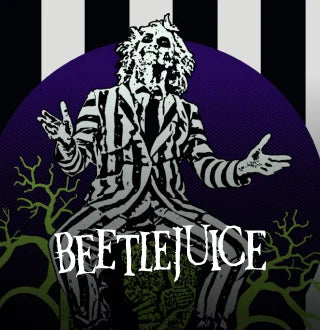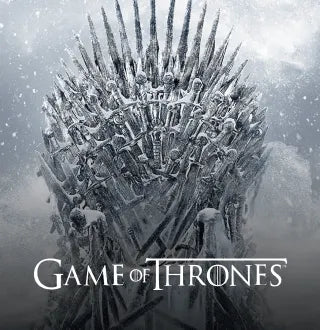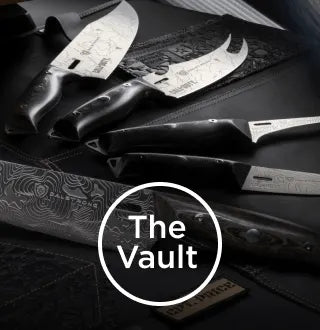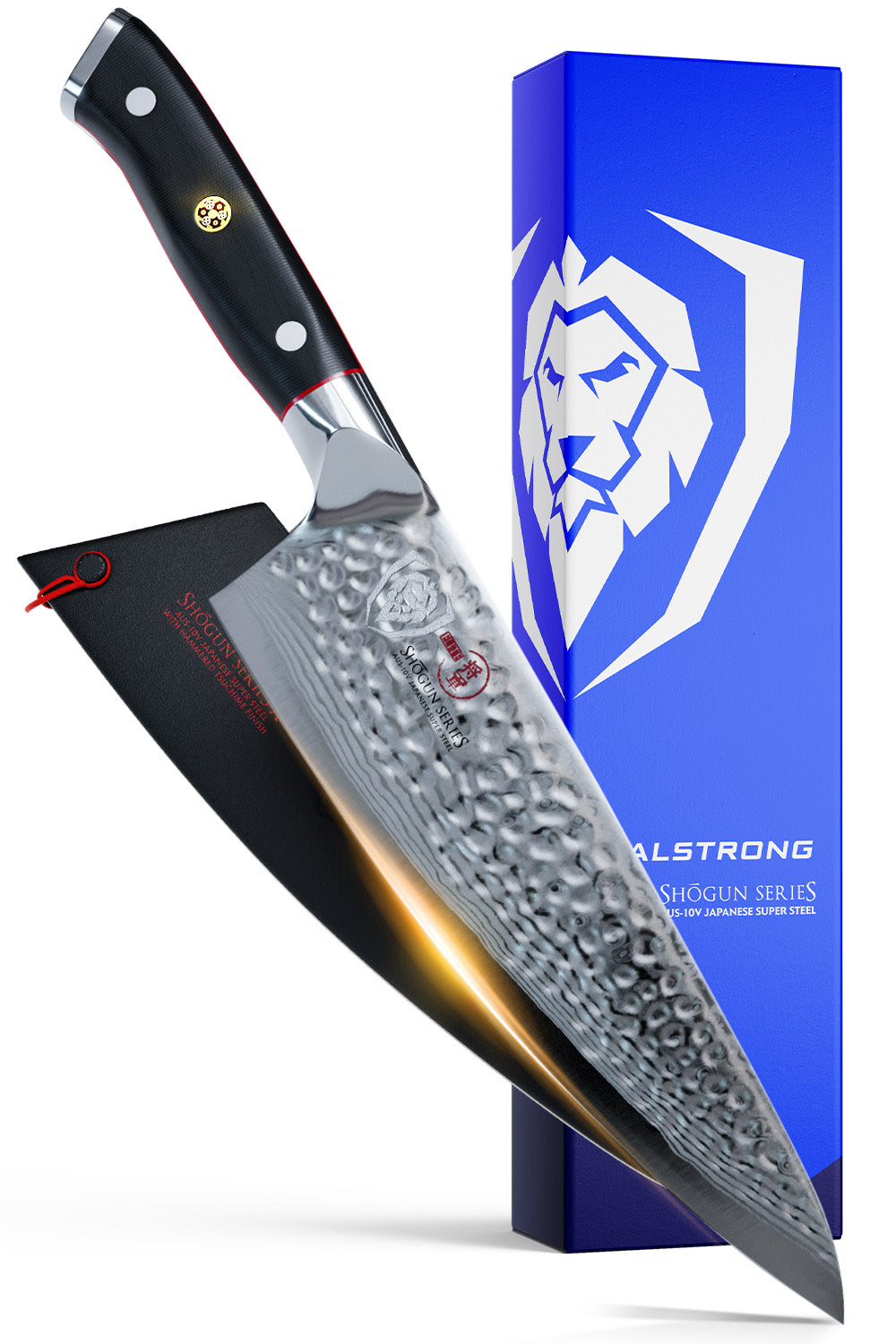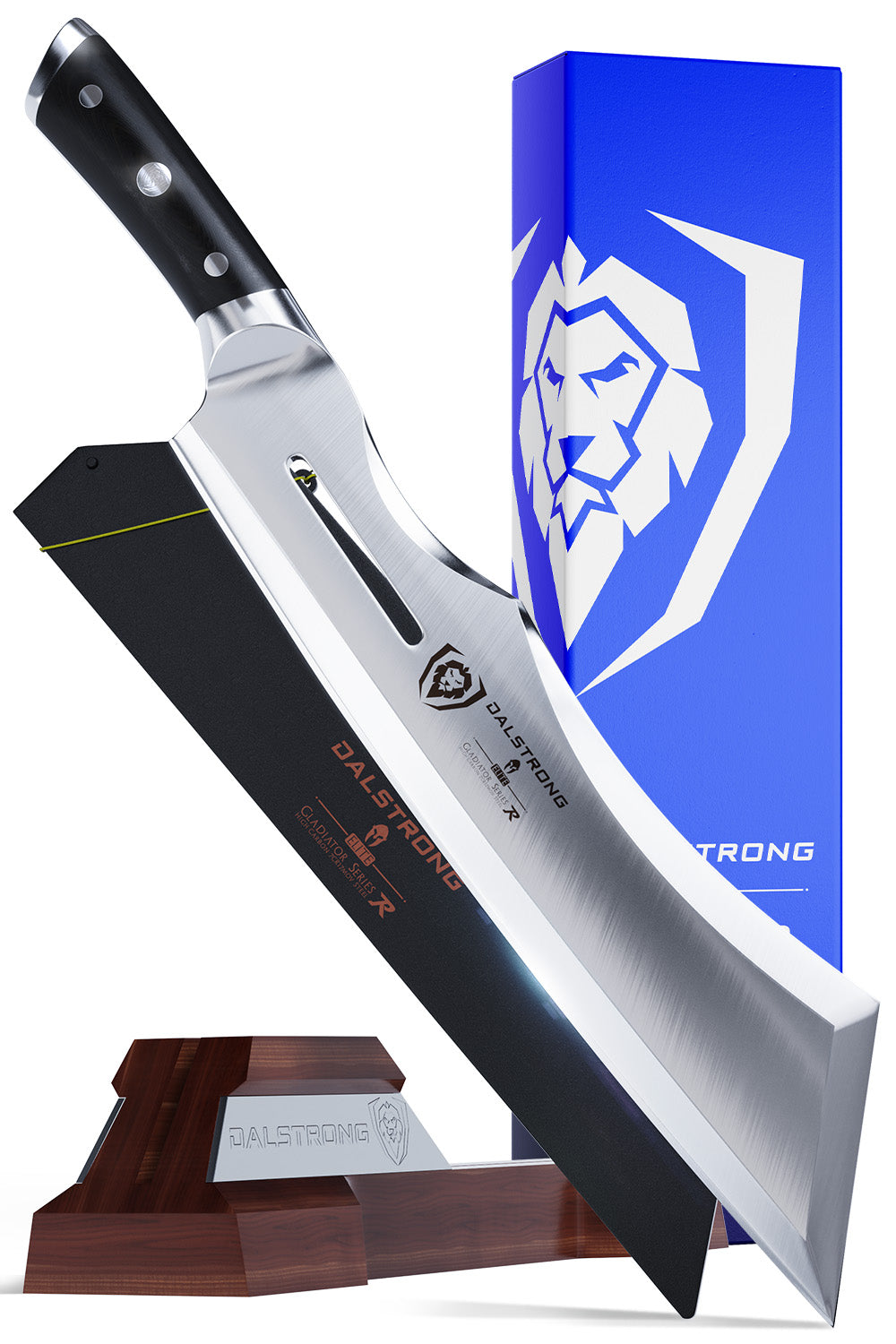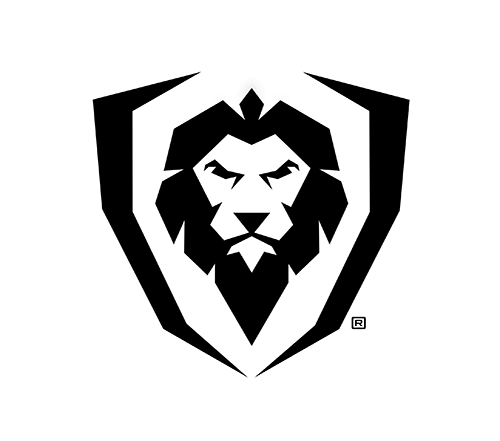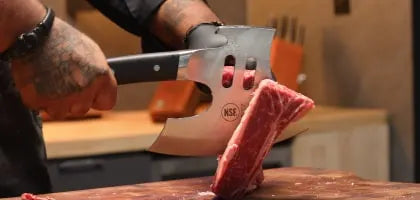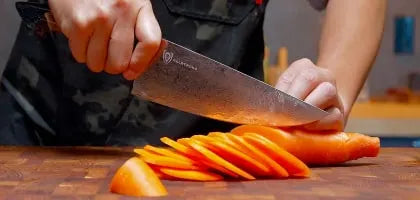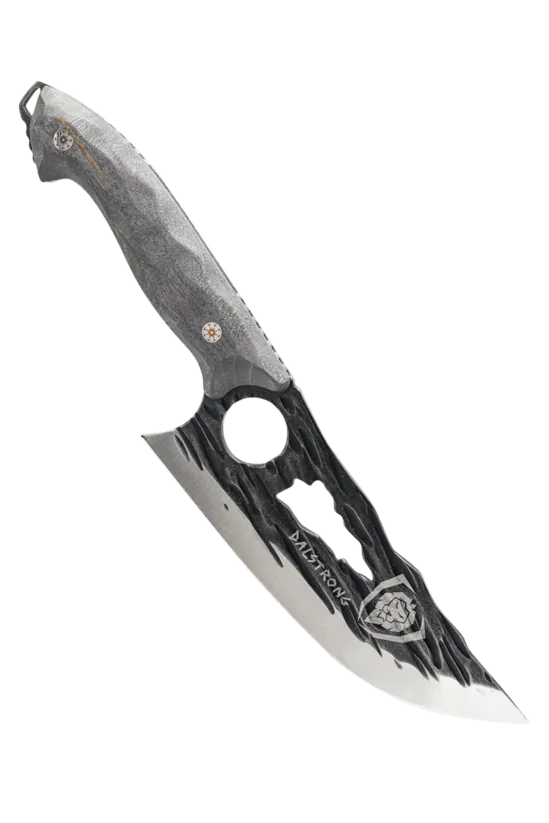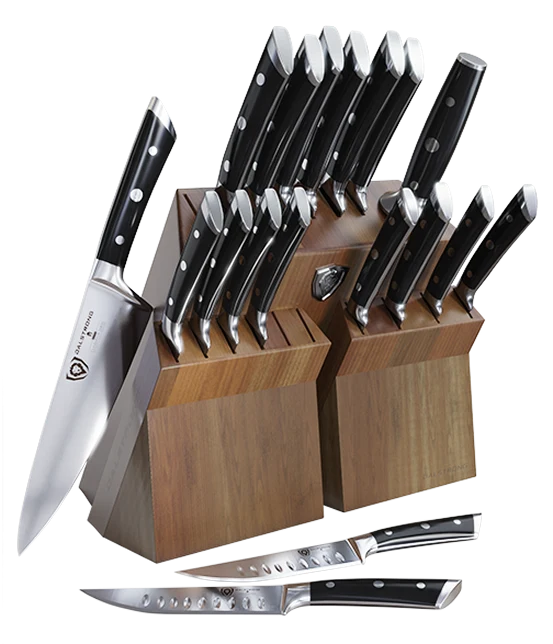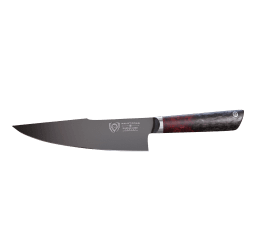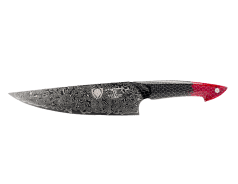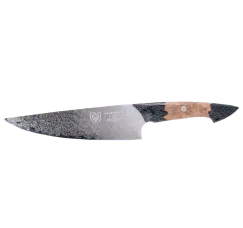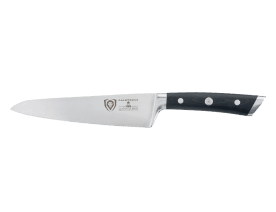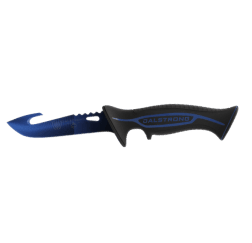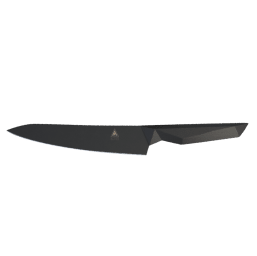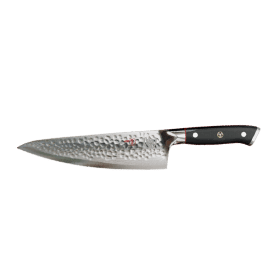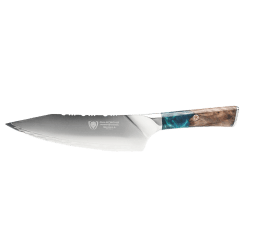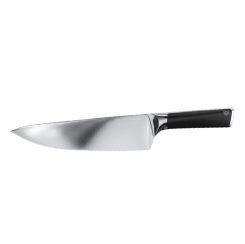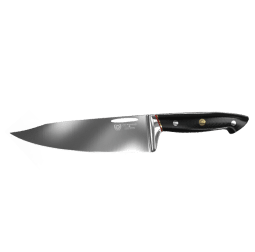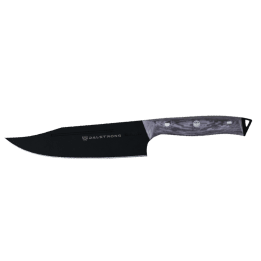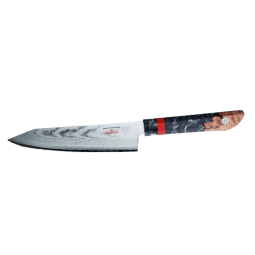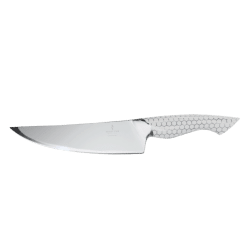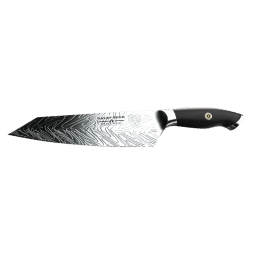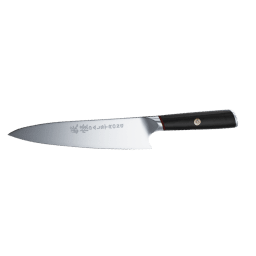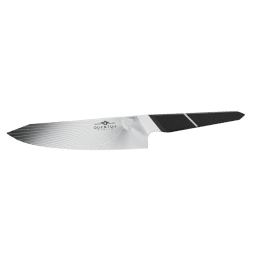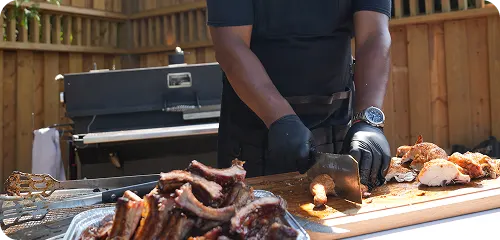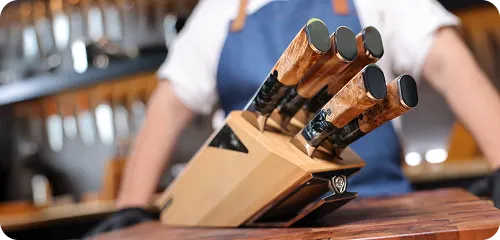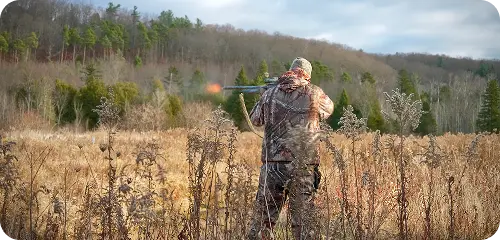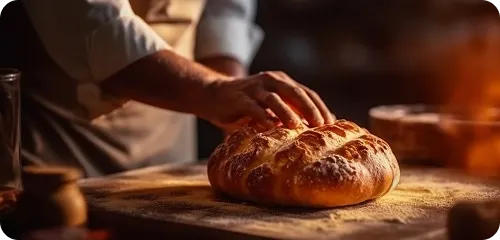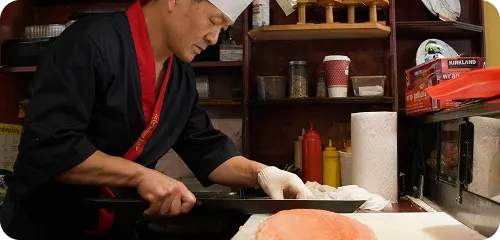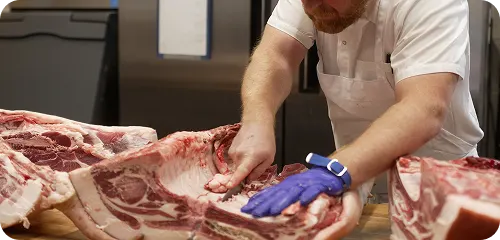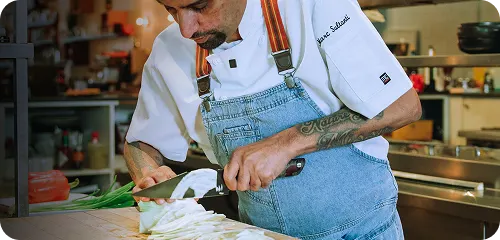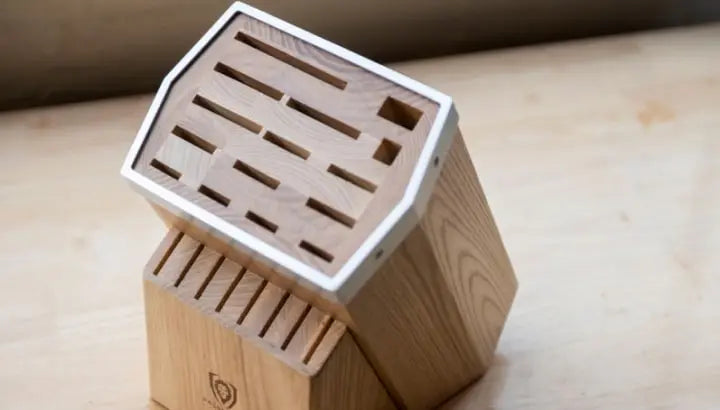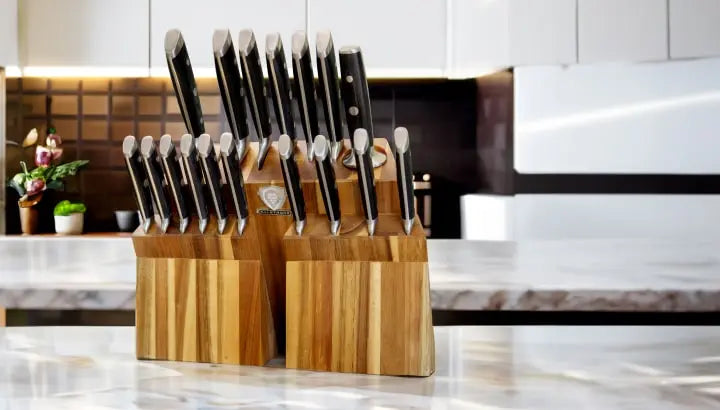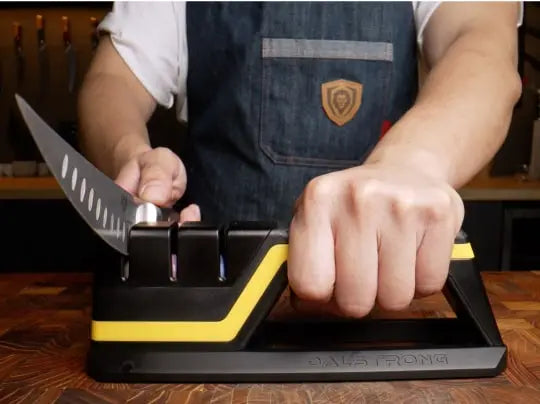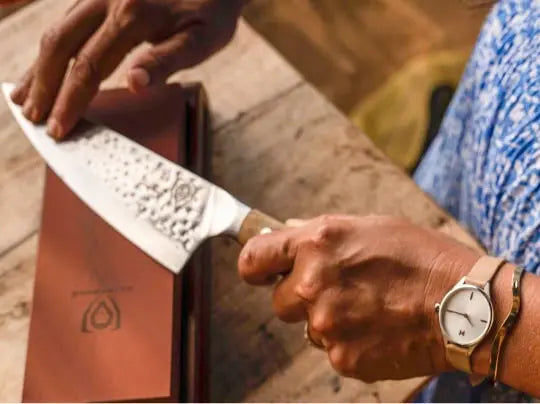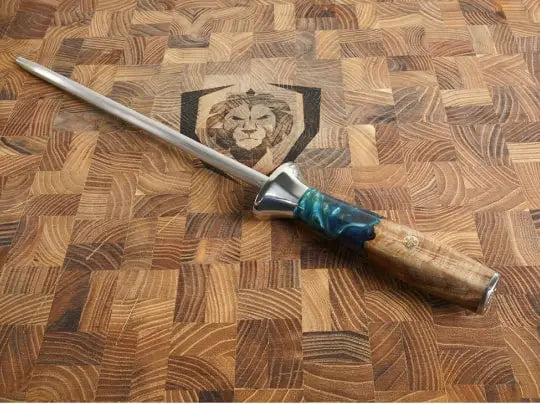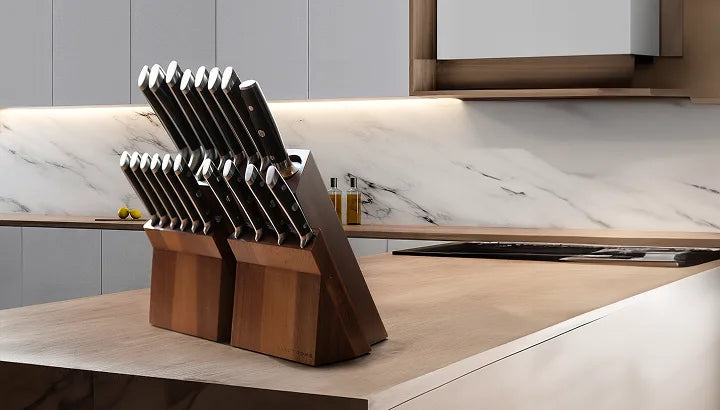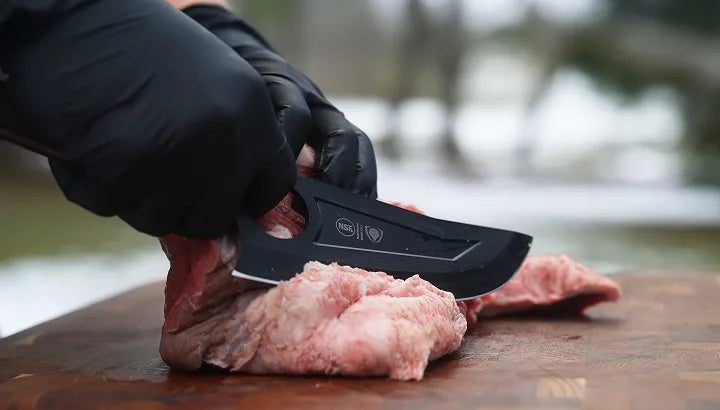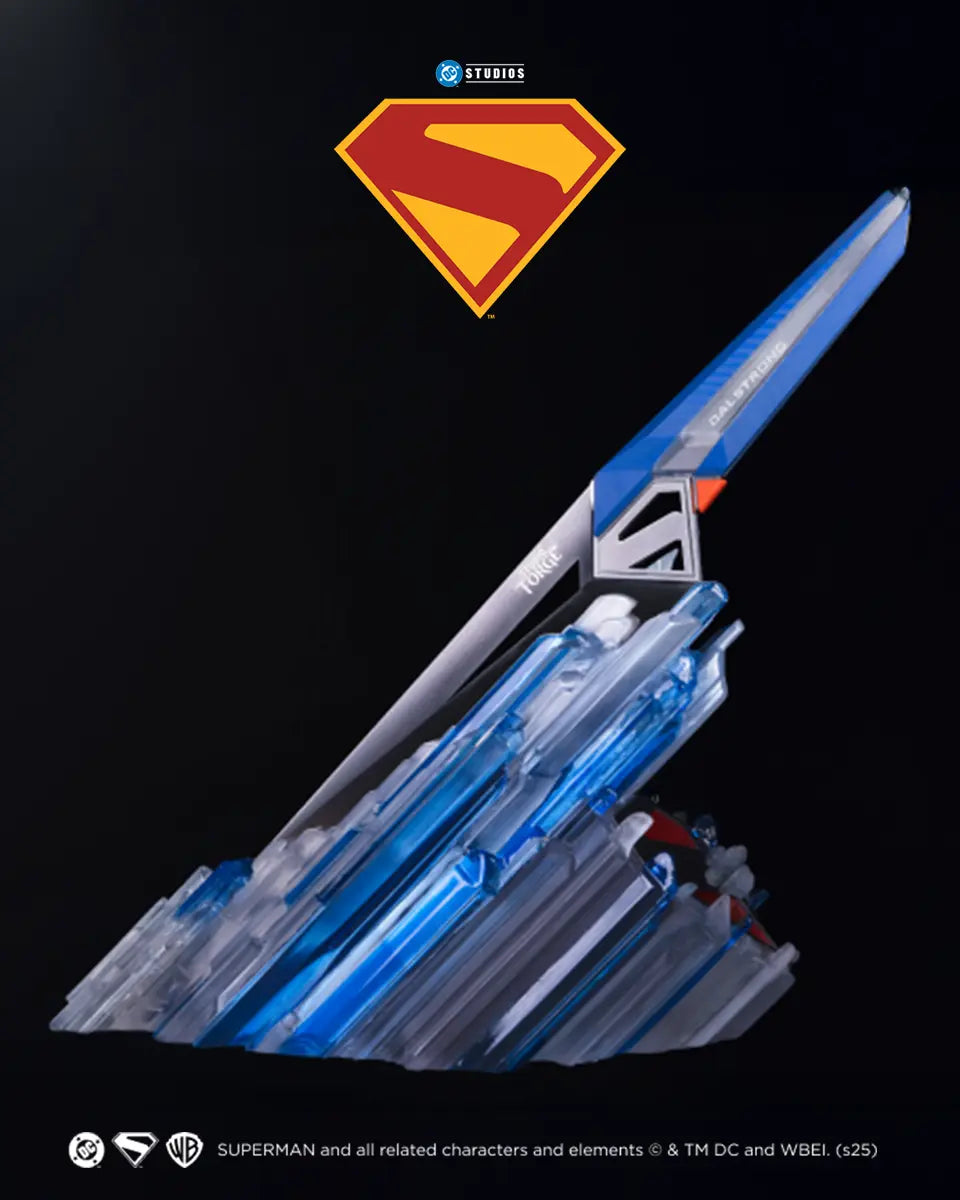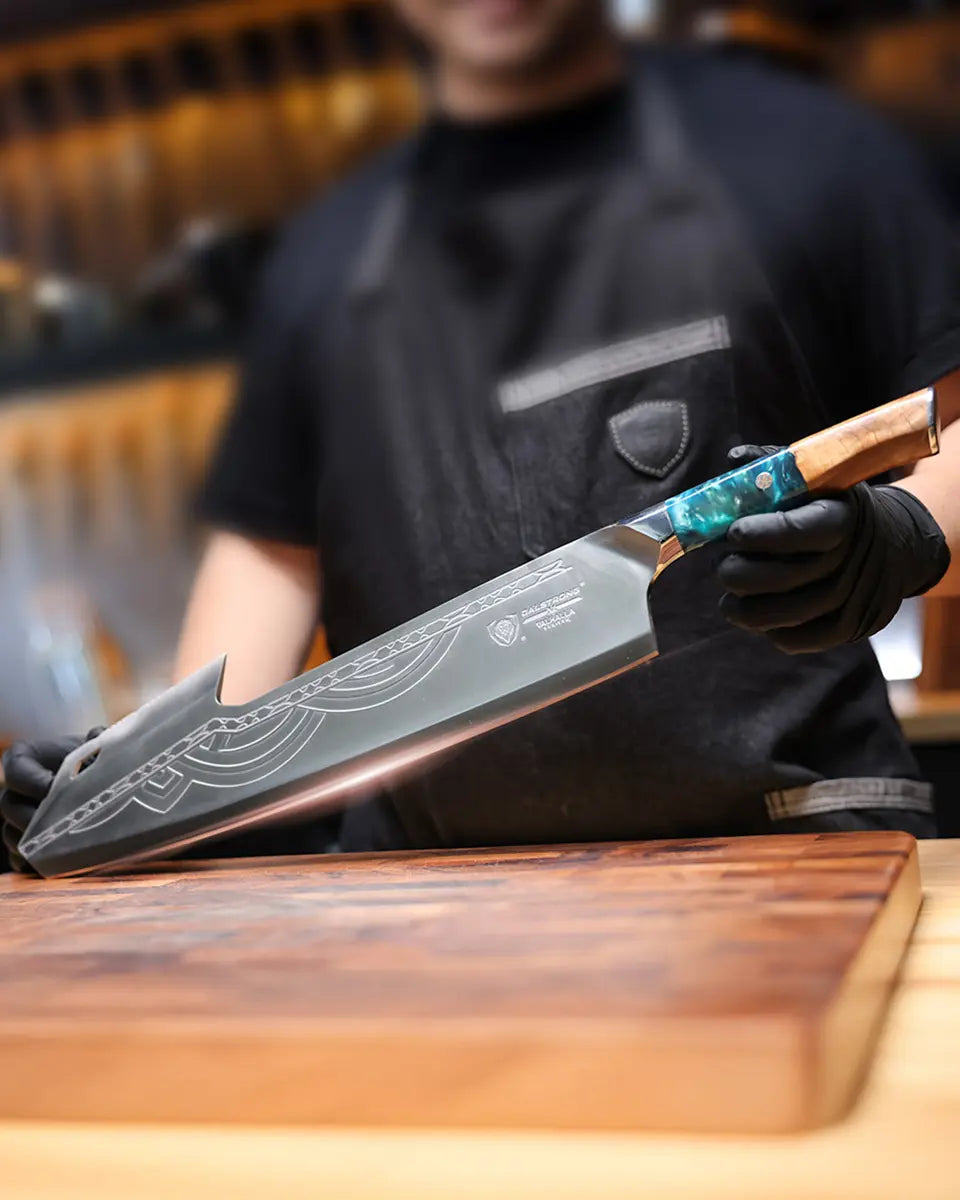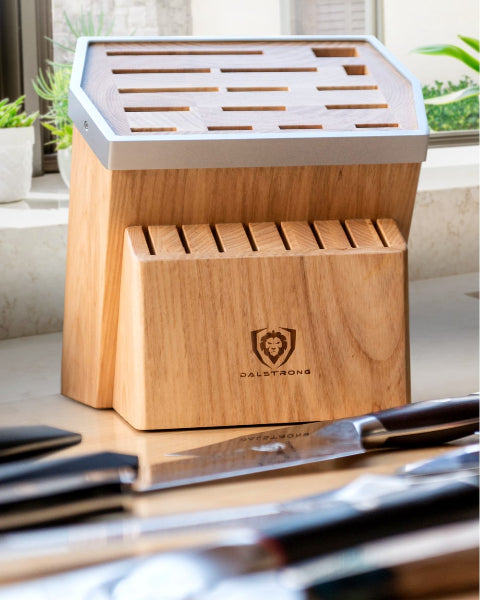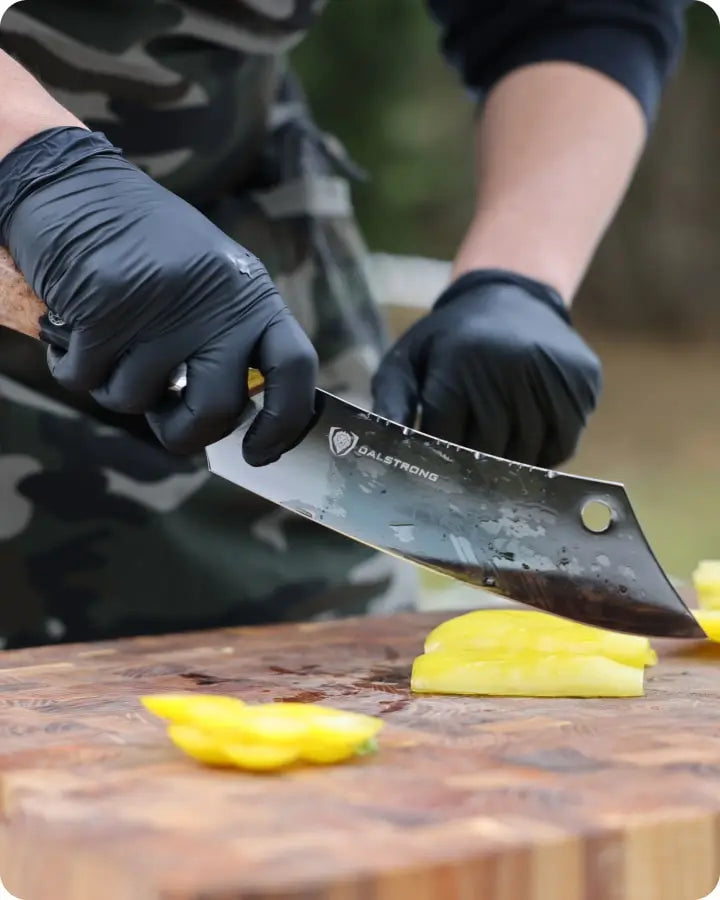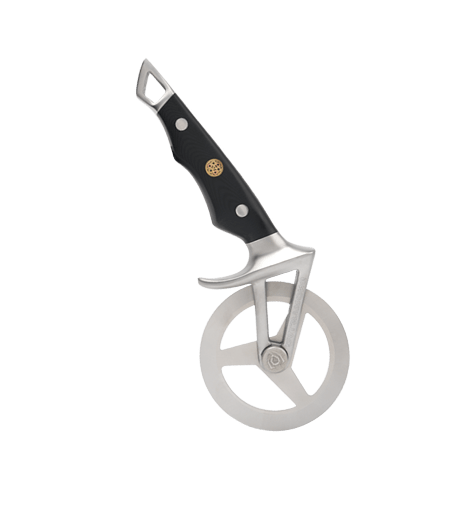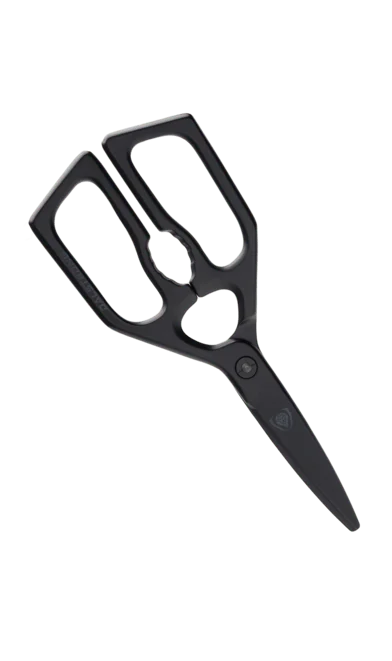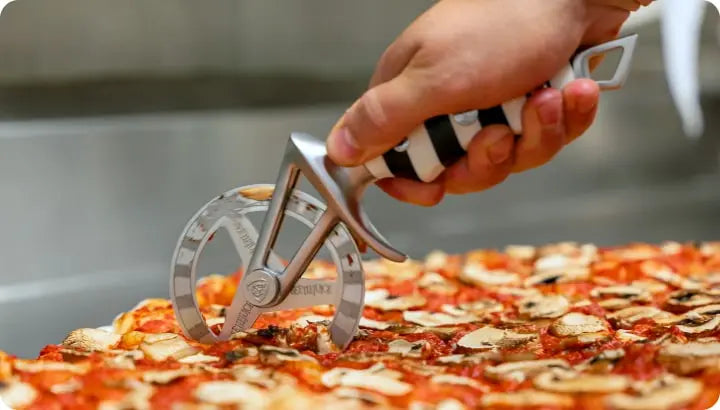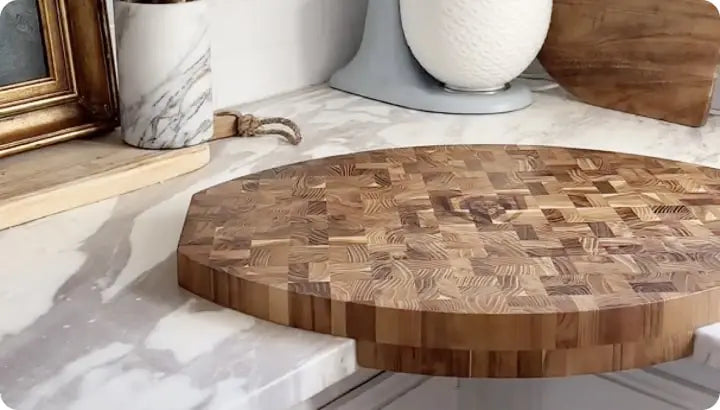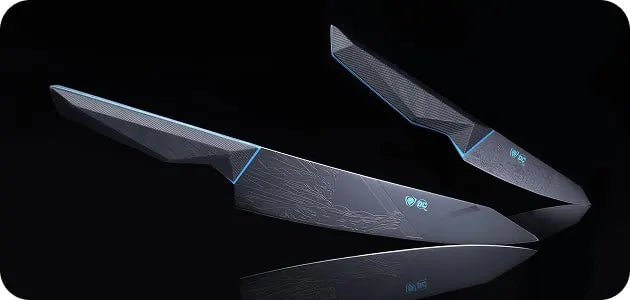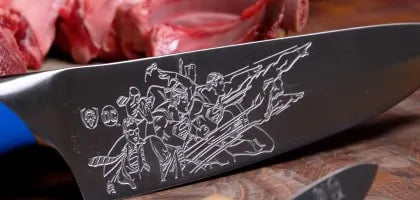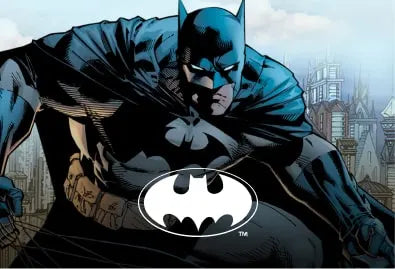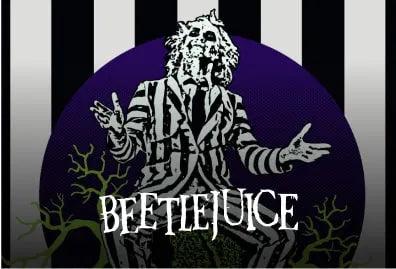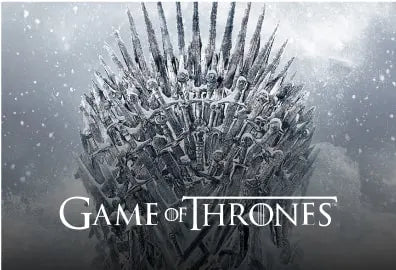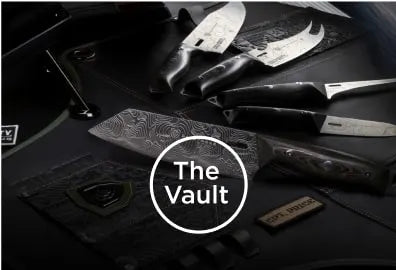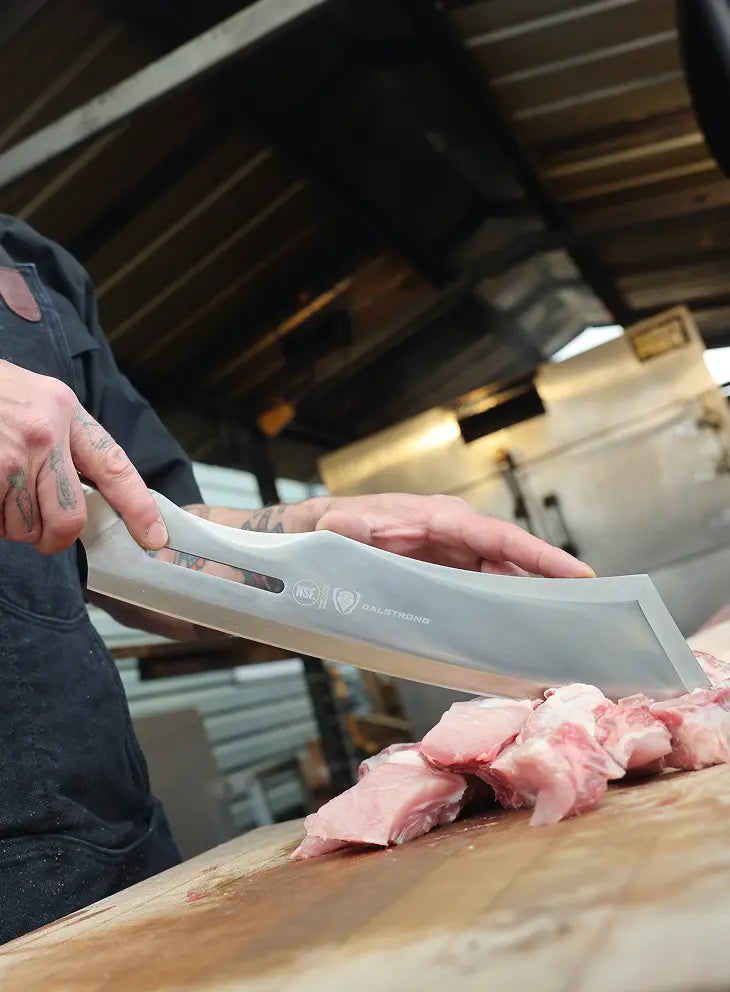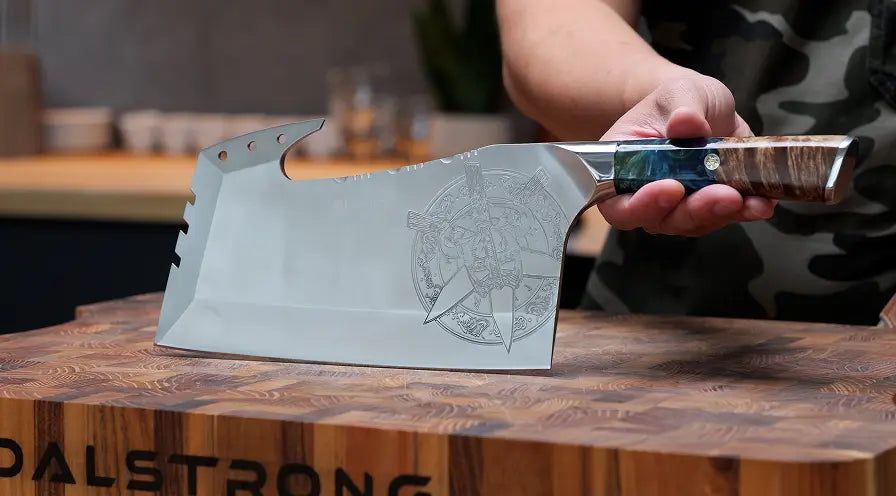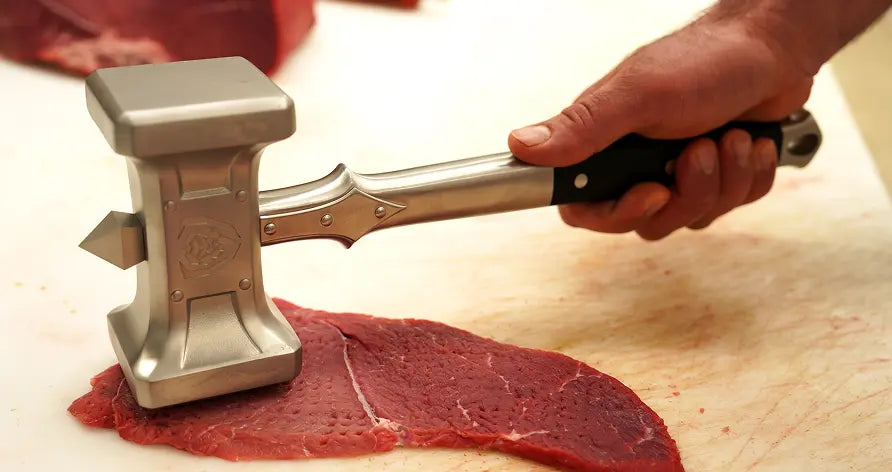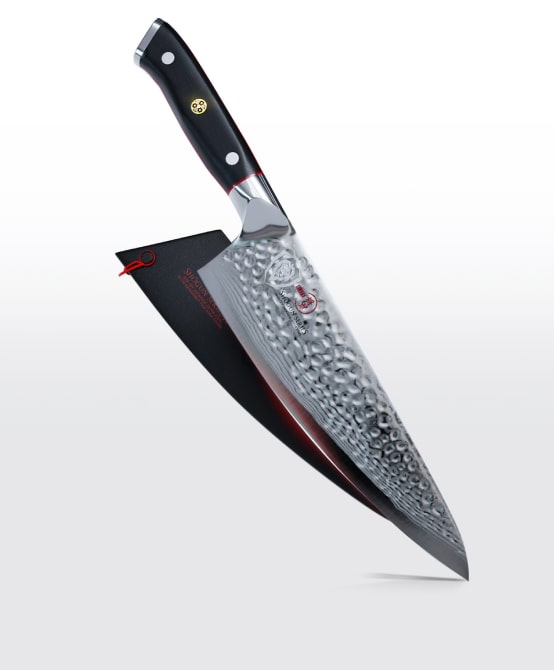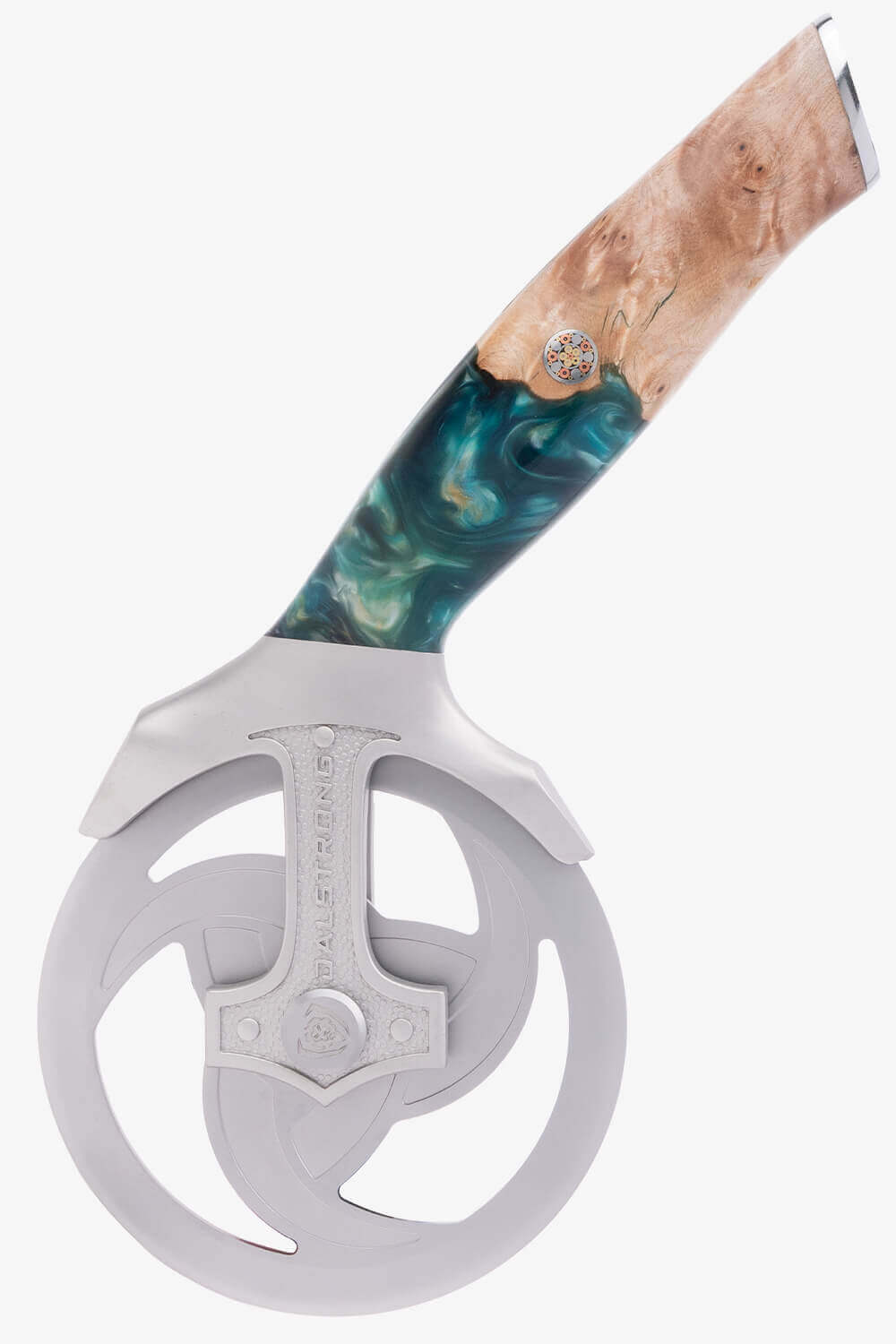A good butcher never blames their tools—unless, of course, they’re using the wrong knife. Then, by all means, blame away.
1. What Is A Breaking Knife?
The breaking knife is one of the main go-to tools of the butchering world. With a curved blade and a sharp tip, this knife is specifically designed to break down large pieces of meat into smaller, more manageable cuts. Unlike a chef knife, which is great for chopping and dicing, a breaking knife is built for power and precision, slicing through fat, cartilage, and sinew with ease.
In terms of butcher knifes, picture a cimitar knife but slightly smaller and more maneuverable -- that’s a breaking knife. Its curved breaking design allows for clean, efficient cuts that don’t waste precious meat. And if you’re a professional butcher, you know wasted meat equals wasted money.
2. Why The Right Breaking Knife Matters For Professional Butchers
If you’ve ever tried to break down a side of beef with the wrong knife, you already know how quickly things can go south. A blade that’s too dull, too short, or just plain uncomfortable will turn what should be a smooth, efficient process into an exhausting wrestling match with the meat. And nobody wants that -- not your hands, not your back, and certainly not your sanity.
Not all butcher knives are built the same, and if you're serious about your craft, using the right breaking knife is non-negotiable. A good test butchers knives run should tell you pretty quickly that the difference between a decent blade and a great one isn’t just about sharpness -- it’s about control, comfort, and longevity.
A high-quality breaking knife ensures:
- Cleaner cuts – No more hacking away like an amateur, leaving jagged edges and uneven pieces of meat that look like they lost a fight. A proper curved breaking knife gives you long, fluid strokes that maximize precision.
- Better efficiency – When you’re working in a busy butcher shop, speed matters. The right knife makes each movement count, helping you process more meat in less time.
- Less hand fatigue – Butchering is already a physically demanding job. A well-designed breaking knife with an ergonomic grip takes some of the strain off your hands, wrists, and forearms. Because nothing ruins a long shift like a cramp from a bad grip.
- Longer blade life – A corrosion-resistant knife that holds an edge means you’re not reaching for the knife sharpeners every five minutes. It also means your knife won’t rust out on you after a few rounds with wet meat.
One of the biggest things to consider when choosing a breaking knife is the blade material. The best butcher knives are made from high-carbon stainless steel, which provides the best of both worlds -- tough enough to take a beating but hard enough to stay sharp longer. A corrosion-resistant finish is a must, especially if you’re working in high-humidity environments or constantly washing down your equipment.
In short, the right breaking knife isn’t just about making your job easier -- it’s about making sure every cut counts. Whether you’re working through an entire side of beef or just trimming smaller cuts of meat, investing in a quality blade is one of the smartest moves a professional butcher can make.
3. What Makes A Knife Perfect For Butchering
A professional butcher needs more than just one good knife -- it’s about having the right knife sets for different tasks. Each knife serves a purpose, and while a breaking knife is crucial for handling large cuts of meat, it’s not the only tool in a butcher’s arsenal.
The difference between a breaking knife and a regular kitchen knife isn’t just about size. A kitchen knife is designed for all-purpose slicing and dicing, whereas a breaking knife is built specifically for tackling pieces of meat with precision and efficiency. This means it has a curved blade for clean slicing, a strong spine for durability, and a handle that doesn’t slip when things get messy.
Here’s what makes a breaking knife stand out from your average kitchen knives:
- Curved Blade – This isn’t just for aesthetics. The curved blade allows for long, sweeping cuts, helping butchers break down large pieces of meat without unnecessary sawing. The motion is smooth and controlled, preventing ragged cuts that can ruin the texture of the meat.
- Blade Length – A standard breaking knife is typically 8 to 10 inches, but for heavier-duty tasks, some butchers prefer a heavyweight butchers knife with a longer blade. The extra length provides leverage when working through larger cuts of meat.
- Granton Edge – Those little dimples along the side of some butcher knives aren’t just for show. A Granton edge creates small air pockets that prevent meat from sticking to the blade, making slicing more effortless and reducing friction.
- Ergonomic Handle – When you’re working a long shift, hand fatigue is real. A properly designed breaking knife has a comfortable, non-slip handle that allows for extended use without discomfort.
Read about the best way to store your knives, here.
Of course, butchers don’t just rely on a breaking knife alone. There’s a reason chefs knives, carving knives, steak knives, and boning knives all have their place in a professional setting. For example, a carving knife is useful for slicing precise portions, while steak knives ensure a clean cut when serving a finished product. And when it comes to durability, high-carbon stainless steel is the material of choice for professionals -- it keeps an edge longer and resists wear and tear, making it a reliable investment for any butcher’s toolkit.
A Dalstrong, Dexter Russell or Victorinox curved breaking knife is a great option for butchers who demand quality. These brands have been trusted in professional kitchens and butcher shops for years, offering everything from fillet knives and boning knives to full knife block sets for those who want a complete butchering toolkit.
4. Essential Features Of Breaking Knives
A breaking knife isn’t just another tool in the butcher's arsenal -- it’s a critical piece of food equipment that separates a clean, professional cut from a jagged mess. Whether you're slicing through thick cuts of meat in a butcher shop, breaking down fish at a seafood market, or even processing wild game, the right knife makes all the difference. But what exactly makes a breaking knife stand out from the rest?
Blade material
If there’s one thing you don’t want, it’s a knife that goes dull halfway through a shift. The best butcher knives according to professionals are made from high-carbon stainless steel -- a material that offers the perfect balance of durability and sharpness. This type of steel holds its edge longer, resists corrosion, and can handle the daily abuse of professional butchering.
Many high-quality knives, like Dexter Russel knives, are designed with corrosion-resistant properties to withstand the constant exposure to moisture and raw meat. The last thing you need is a rusted-out blade when you’re knee-deep in a busy workday.
Blade length
When picking out a breaking knife, size should be a concern! Most curved breaking knives fall within the 8 to 10-inch range, giving you enough length for smooth slicing without sacrificing control. However, if you’re regularly working with larger pieces of meat, you might want to upgrade to a heavyweight butcher’s knife with a longer blade for better leverage.
For those who process wild game or fish, a curved boning knife is another great addition to your toolkit. While a breaking knife excels at portioning and trimming, a curved boning knife is designed for precision work -- like separating meat from the bone without unnecessary waste.
Handle grip
A great knife isn’t just about the blade. If you’ve ever spent hours working through a butcher knife set, you already know that a poor handle can turn a good knife into a nightmare. A proper breaking knife should have an ergonomic handle that provides a firm, non-slip grip -- even when your hands are wet or greasy.
Comfort is key here. A knife that feels like a brick in your hand is going to lead to fatigue and sloppy cuts. The best knives feel natural, giving you full control without putting unnecessary strain on your wrist.
Edge type
Ever wonder why some knives have those little dimples along the blade? That’s a Granton edge, and it’s a game-changer for butchers. Those shallow indentations create small air pockets that prevent meat from sticking to the blade. This means cleaner cuts, less friction, and a smoother workflow.
While a Granton edge is commonly found on fillet knives, skinning knives, and boning knives, it’s also a fantastic feature for breaking knives, especially when working with fatty meats.
Maintenance & storage: Keeping your breaking knife in top condition
A knife is only as good as the care you give it. Proper storage and maintenance can extend the life of your butcher knife set, keeping your blades sharp and in top condition.
- Knife sharpeners – A dull knife is a dangerous knife. Regular sharpening keeps your breaking knife in prime condition.
- Knife blocks & knife storage – Many professionals prefer knife blocks to keep their blades protected and organized. A knife block set not only saves space but also helps extend the lifespan of your tools.
- Cutting boards – A high-quality board prevents unnecessary wear on your blade. Avoid glass or ceramic boards -- they’ll destroy your edge faster than you can say “resharpen.”
In short, the right breaking knife is more than just a sharp blade. It’s about the material, length, handle, edge design, and proper care. Invest in quality, and you’ll save yourself time, frustration, and a whole lot of unnecessary effort.
5. Dalstrong’s Best Breaking Knives For Professional Butchers
1. Shogun Series Butcher & Breaking Knife 12.5"
If you're serious about butchering, this knife is the real deal. The Shogun Series 12.5” Butcher & Breaking Knife is a beast -- long, sharp, and built to handle everything from breaking down large cuts of beef to trimming fat with precision. The AUS10V Japanese Super Steel core means it stays razor-sharp, and the 66-layer Damascus construction makes it as tough as they come. The hammered Tsuchime finish isn’t just for looks -- it helps prevent food from sticking so you get smoother, cleaner cuts. And with a full tang, triple-riveted handle, this thing feels solid in your hand.
PROS:
- The AUS10V Japanese Super Steel core holds an edge for ages, so you're not constantly sharpening it.
- The hammered Tsuchime finish keeps meat from sticking, making slicing way smoother.
- The military-spec G10 fiberglass handle is tough, comfortable, and won’t slip, even when your hands are messy.
- It comes with a PerfectFit™ Sheath, so you can store it safely without worrying about damaging the edge.
CONS:
- At 12.5 inches, it’s a big knife -- great for professionals, but it might take some getting used to if you're more familiar with smaller blades.
- The high-hardness steel (62+ HRC) means it stays sharp, but it also requires proper care and sharpening to keep it in top shape.
2. Dalstrong Delta Wolf Butcher & Breaking Knife 10"
If the Shogun 12.5” Butcher Knife is a powerhouse built for big jobs, the Delta Wolf 10” Butcher Knife is its sleek, tactical counterpart. With a savagely curved blade and a black titanium-nitride coating, this knife doesn’t just look cool -- it’s designed for serious butchering. The 10-inch high-carbon steel blade is ultra-thin (just 1.6mm thick), making it nimble enough to carve through meat with precision while still tough enough to break through cartilage and sinew. The Granton edge keeps drag to a minimum, and the G10 camouflage handle is built to take a beating -- resistant to heat, cold, impact, and basically anything else you throw at it..
PROS:
- The 10-inch high-carbon steel blade is thinner and more agile than the Shogun 12.5”, making it ideal for precision cuts.
- The black titanium-nitride coating not only looks badass but also improves corrosion resistance and keeps food from sticking.
- The Granton edge reduces drag, so slicing through meat feels smooth and effortless.
- The G10 camouflage handle is built for extreme durability, resisting temperature changes, impact, and chemicals better than most.
CONS:
- The ultra-thin 1.6mm blade is great for slicing, but it won’t have the same heft for heavy-duty breaking as the 12.5” Shogun.
- The black-coated blade is sleek and tactical, but some may prefer the classic Damascus look of the Shogun Series.
3. Dalstrong Phantom Series Butcher & Breaking Knife 10"
If the Shogun 12.5” Butcher Knife is built for brute force and the Delta Wolf 10” Butcher Knife is a sleek tactical slicer, the Phantom Series 10” Butcher & Breaking Knife is all about elegance and precision. This knife isn’t just designed to butcher -- it’s designed to glide through beef, pork, poultry, and fish with a level of finesse that sets it apart. The curved cimeter-style blade allows for smooth, controlled slicing, while the rock-hollow divots help prevent meat from sticking, making large-scale butchering more efficient. The AUS-8 Japanese steel blade is incredibly sharp, ice-tempered for resilience, and polished to a mirror-like finish. The pakkawood handle, accented with a striking red spacer and a brass-copper mosaic, gives it a refined, comfortable grip.
PROS:
- The curved cimeter-style blade makes skinning and portioning smoother and more efficient than standard breaking knives.
- The rock-hollow divots prevent meat from sticking, reducing friction and making slicing easier.
- The AUS-8 Japanese steel blade, hand-sharpened to 13-15°, is scalpel-sharp and ice-tempered for resilience.
- The pakkawood handle is both beautiful and ergonomic, offering a refined grip that feels great in hand.
CONS:
- The partial tang design is sturdy but doesn’t have the full tang reinforcement of the Shogun or Delta Wolf knives.
- The high-polish finish looks stunning but may require more maintenance to keep it fingerprint-free compared to the matte black Delta Wolf blade.
4. Dalstrong Gladiator Series Butcher & Breaking Cimeter Knife 8"
The Gladiator Series 8” Butcher & Breaking Knife strikes a perfect balance between control and maneuverability. With its high-carbon German ThyssenKrupp steel blade, this knife is tough, sharp, and ready for anything from steak slicing to brisket trimming. The 8-inch curved cimeter blade gives you the leverage needed for clean cuts while staying small enough to handle intricate work without feeling cumbersome. The full tang, triple-riveted G10 handle is built for durability, resisting heat, cold, and moisture. Whether you’re breaking down large game or working through smaller cuts, this knife offers the flexibility and control to get the job done with ease.
PROS:
- The 8-inch blade is more maneuverable than the longer breaking knives, making it easier to handle for detailed work.
- The high-carbon German ThyssenKrupp steel ensures durability and sharpness while still being easy to maintain.
- The full tang, triple-riveted G10 handle is built for lifelong durability and resists heat, cold, and moisture.
- The tall blade height gives extra knuckle clearance, making it easier to work on large cuts of meat without hitting your fingers.
CONS:
- The 8-inch length may feel too small for those used to the reach of a 10” or 12.5” breaking knife.
- The 16-18° edge is slightly less sharp than the Phantom Series’ 13-15° edge, though it offers more resilience for heavy-duty use.
5. Dalstrong Gladiator Series Bull Nose Butcher & Breaking Knife 8"
This knife has got all the muscle of a larger breaking knife but in a more compact, easy-to-handle size. The bull nose design isn’t just for show -- the slightly rounded tip extends the cutting edge and gives extra weight up front, so slicing through cartilage, fat, and thick cuts of meat feels effortless. The high-carbon German steel blade is sharp, durable, and tough enough to break down beef, pork, poultry, fish, and even wild game without a hitch. The G10 handle is built like a tank, meaning no matter how messy things get, you’ll always have a solid, comfortable grip. If you like precision and control but still want something that can handle serious butchering, this knife is a great pick.
PROS:
- The bull nose shape adds weight to the tip, helping you power through tough cuts with less effort.
- The 8-inch blade is nimble and easy to control, making it great for more detailed butchering work.
- The full tang, triple-riveted G10 handle is tough, comfortable, and holds up against heat, cold, and moisture.
- The high-carbon German steel blade, sharpened to 16-18°, balances razor-sharp performance with durability.
CONS:
- The shorter blade means it’s not ideal for breaking down really large cuts like a 10” or 12.5” knife would be.
- The bull nose tip adds a little extra weight to the front, which takes some getting used to if you’re more familiar with traditional breaking knives.
6. Frequently Asked Questions
What kind of knife is best for butchering?
The best knives for butchering depend on the task. A breaking knife is ideal for slicing through large pieces of meat, while a boning knife helps separate meat from bones. A fillet knife is best for delicate cuts, especially for fish, and a skinning knife is essential for removing hides cleanly.
What knives should every butcher have?
A professional butcher should have a curved breaking knife for large cuts, a boning knife for removing bones, and a fillet knife for precise slicing. A skinning knife is necessary for hide removal, while a cimitar knife helps trim and portion larger sections of meat. Utility knives and paring knives handle smaller, detailed tasks.
What size knife is best for a butcher?
For breaking knives, an 8 to 12-inch blade is ideal. Butchers working with larger pieces of meat may prefer a longer blade, while smaller knives offer more control.
What is the sharpest knife to cut meat?
Top choice for sharpness include Dalstrong's breaking knives for their incredible performance and style. High-carbon stainless steel knives hold an edge longer, making them ideal for butchers needing consistent sharpness.


